What is the American Dream in art? Is there an American Dream in art? How to live the American Dream in art? Being a full-time artist can be difficult, especially in the first years. Your art may not live up to your expectations and you are not able to make ends meet. You are also presumably faced with lots of pressure if you happen to get a degree in fine arts. You are told that the ultimate goal of your creative existence is to impress the critics. However, in order to impress the critics, you need to come up with something they have never seen or experienced before. So how do you think of something uniquely creative and make ends meet?
As I was doing research, I encountered a story that immediately stood out to me with its peculiar creativity, success, and, well, American Dream!

Daily Paintings with Carol Marine
Carol Marine has become my personal epitome of the American Dream. Her life and initiatives are a testament of what it means to not just persistently pursue what she loves, but derive joy and happiness from it.
In today’s post, I am pleased to feature an interview with an artist who has always believed in doing what she loves. In her childhood home, her parents always told her, if you do what you love, you may not be rich, but you will be happy. This happiness has become a quintessence of the American Dream in art and life for her and her family.
Despite some challenging moments in life, when she felt exhausted with artistic creation or when her house was burnt down in a forest fire in Texas in 2011, she never gave up on what she loved doing.
She came forward with the idea of a daily painting, painting small but frequently. This allowed for a quick improvement in artistic skills, and, at the same time, prevented artists from becoming burnt out with painting. Thus, each day could be a new day.
Her daily works of art are gorgeous. And, the idea of daily paintings gave rise to the community of artists in Daily Paintworks. There, artists from different walks of life can showcase and auction off their art. Carol Marine posts frequently on her blog Carol Marine’s Painting a Day and has her own Gallery, which I do invite you to explore.
Exclusive interview with Carol Marine
Adam Ziemba: What were some important values that your family fostered in your childhood home?
Carol Marine: My parents created a wonderful home, nourishing and instilling values that I have gratefully carried in life. They emphasized the importance of hard work and self-sufficiency. With their endless entrepreneurial drive, my parents always found ways not to rely on others. They are the ultimate “do-it-yourself” role models. As you can imagine, this mentality has inspired my strong work ethic, persistence and passion.
AZ: Have you ever had any doubts about being an artist?
CM: I had two moments of doubt on different occasions in my life.
First, when I was in my junior year at college, I questioned how I would be able to make a living out of art and painting. I wanted to switch to a more practical thing, accounting. Business school did not want to accept me for I had already had too many college hours under my belt.
Second, after 10 years of painting daily, I found myself getting burnt out. This made me pause and take a step back to consider whether painting was the right choice for me.
AZ: You are a happy artist today. How did you resolve your doubts?
CM: First, my husband has been an enormously positive force in encouraging and pushing me to do what I love. Second, I rediscovered balance with art. If I do not feel inspired to paint, I need to do something else, be it reading or writing a book, taking a hike, or simply spending a day with my family. Without that balance, I can consequently get overwhelmed. I have talked to other artists, and I understand that this can happen. It took me a long time to realize this lesson myself.
AZ: How did you discover your passion for art?
CM: When I was a kid, my parents always told me “if you do what you love, you may not be rich, but you will be happy.” They showed us how fundamental it was to do what we loved. I have also learned that everyone can do something that when they do it, they lose track of time. If they can do that thing for a living, they will be the happiest they can be. For me, “that thing” has been always art.
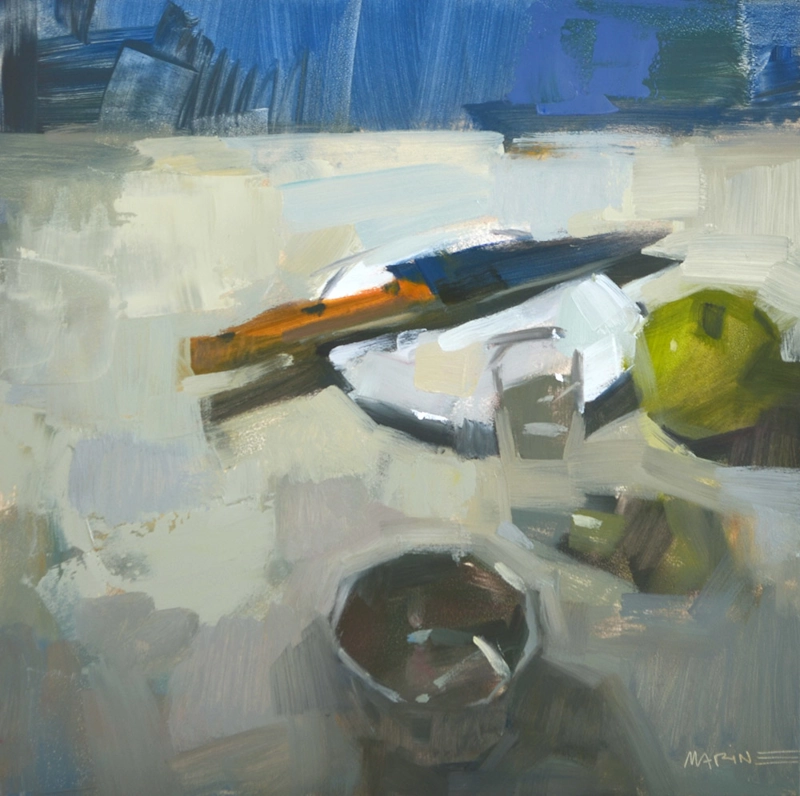
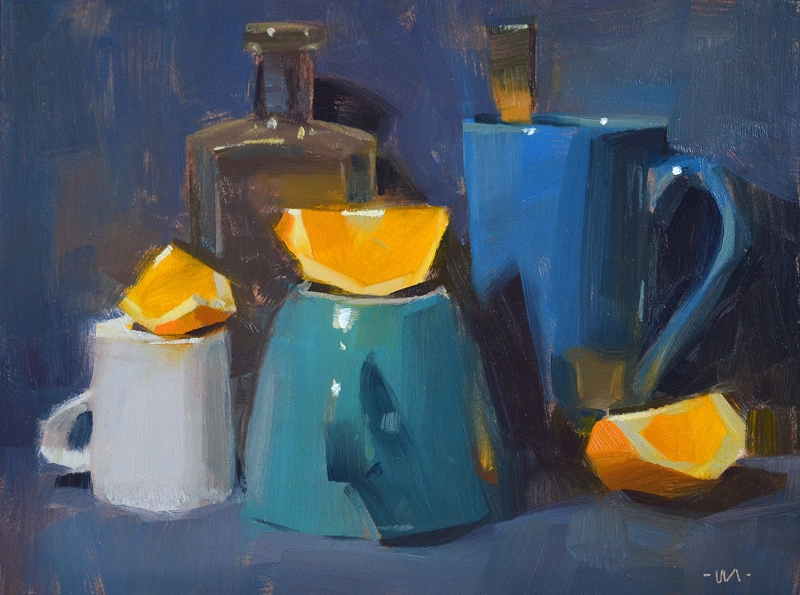

AZ: Do you have any memorable stories from your discovery of passion for art?
CM: I went to a fairly small school, with around 19 children in my class. One day, a teacher came to the room and asked what we would like to do when we grow up. Everyone in the classroom answered for me, “she is going to be an artist!”
AZ: What grade was it?
CM: I think it was either first or second grade. To give you another example, in fourth grade, a teacher gave us a piece of paper with outlines of Easter eggs. She asked us to decorate them. I thought to myself, “how boring.” Instead of following the instructions, I created a 3D scene of the egg. I wanted to be creative all the time.
AZ: What has been your career path to be where you are today? What background do you have in art?
CM: I went to the University of Texas in Austin to pursue a degree in fine arts with focus in oil paintings. My education was primarily theoretical and conceptual. It was about the idea behind the art, what art can tell. Unfortunately, this was not what I wanted to do with art at all.
AZ: What did you want to do with art then?
CM: I was interested in making beautiful pictures. I wasn’t interested at all in making a political or social statement.
AZ: How did your professors respond to this?
CM: My professors oftentimes accused me of being a “sellout.” They emphasized that my goal should not be making a living out of painting. Instead, I was supposed to impress the critics. I was supposed to “show them something that they had never seen before.”
AZ: That’s pretty self-explanatory. Do you think your education was useful?
CM: Yes, for several reasons. First, university provided me with space and time to create art. If I hadn’t gone to school, I wouldn’t have had a studio to paint in. Second, I was able to do a lot of figure drawing, which fantastically contributed to my drawing skills. Even though I never had any formal mentoring on this, I had to do it daily. Third, I really enjoyed my general education classes. I appreciate all the practical things about my education.
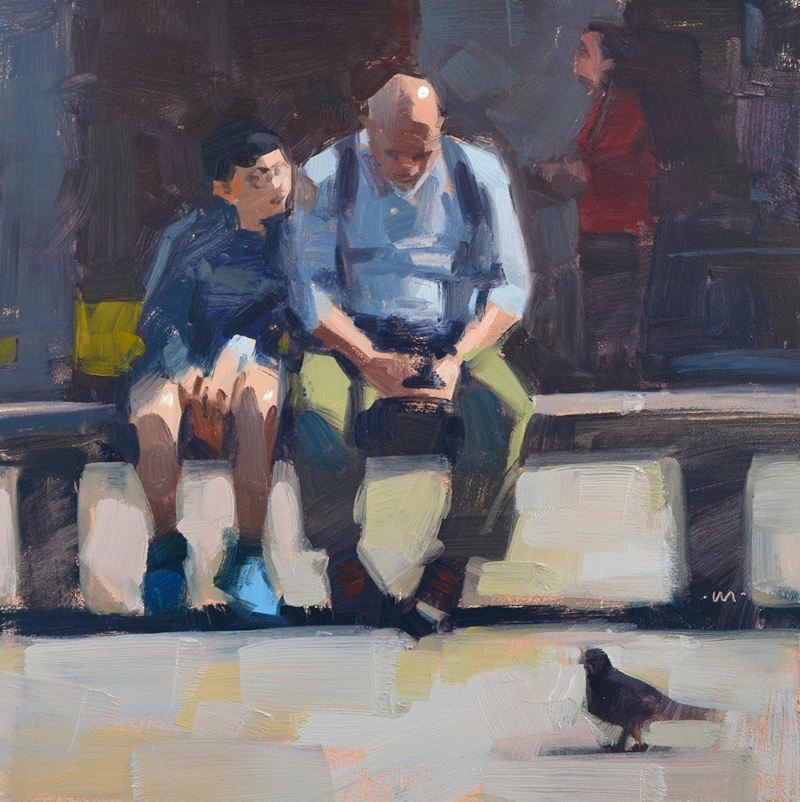
AZ: Did professors mentor you a lot?
CM: One professor once said, during a lecture about color theory , “pink? Pink is a girl color.” It was ridiculous. We never had any fundamentals.
AZ: Were you ever given any practical advice on your paintings?
CM: Well. I took a 4-day workshop well after college. I learned more about painting there than I had learned during my 4 years of college.
AZ: What is the American Dream for you?
CM: My son, who is 11, often asks me if so-and-so is successful. I respond, “I don’t know. Do you think they are happy?” To me, this is an essence of American – life dream. That dream is to do something that makes you happy. I realize that it is not always possible, but I am lucky enough to do it.
AZ: Not only are you an artist, but you promote art by supporting artists across the world. What is Daily Paintworks and how did the idea of Daily Paintworks was first conceived of?
CM: About 10 years ago, I was extremely excited about starting to paint daily. I was able to sell my art through eBay, though it came at a price of incredibly high fees. I also saw many other artists struggling in galleries. To improve our situation, I initiated conversations with some artist friends of mine to have a website of all of us together. The idea was to put in some money together to advertise in a high end art magazine, allowing us some wider exposure.
AZ: Did you get any help setting this up?
CM: My husband is a programmer. I provided a design, and he made it work. I also invited 3 of my daily painting friends to jury remaining daily painters. We had 12 painters in total in the first years.
AZ: So how did you go from 12 painters to almost 1600 artists?
CM: In 2008 my husband lost his job. At that time, we knew that there was enormous interest among artists in being part of Daily Paintworks. We received emails each day asking us to let them join. My husband and I talked about this, and we decided to expand and grow Daily Paintworks. We invited more people.
In 2011, we opened Daily Paintworks up to everyone. Since then, we have continued to add features and improvements.
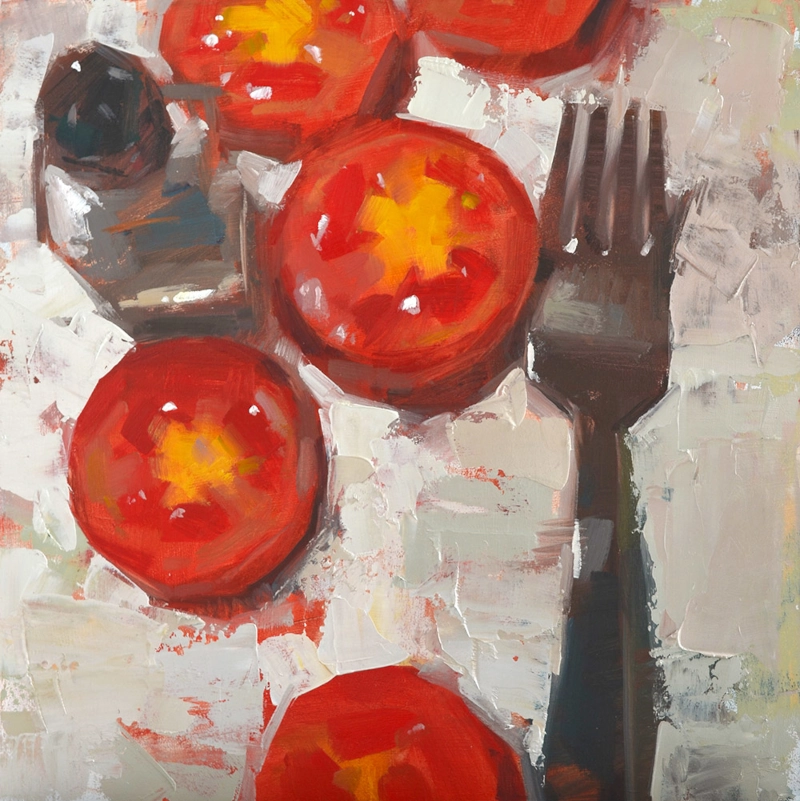
AZ: I know that you actively participate in workshops, with your workshops fully booked through October. What was the most memorable workshop of yours, and why?
CM: Each workshop is distinct and special in my heart. There is this workshop in Texas, which I really like. At the end of it, we all feel like one big family. We spend a night there, with all meals provided. The studio is open all night, and people often paint late into the evening. During this, we share so many personal stories.
AZ: Which workshop are you looking forward to the most this year?
CM: I have never taught abroad, so I look forward to my workshop in France. It will be in English, but I am sure it will be very memorable.
AZ: You have written a book “Daily Painting: Paint Small and Often To Become a More Creative, Productive, and Successful Artist” What was its inspiration?
CM: I started writing that book around 2009. I was hoping to to put all my knowledge from workshops in a book format. Self-publishing a book turned out to be too expensive, so I decided to put everything I had had so far into online tutorials. Each chapter of my book IS one online tutorial, an ArtByte, since they are byte size tutorials.
Then, one day I received a call from Random House. They inquired if I wanted to write a book. I said yes, spent 1.5 years working with them, and the book was published in 2014.
AZ: What is your book’s main message?
CM: The main message is that painting small and often will allow you to learn so fast. I cannot even begin to tell you how amazing it is. With each painting, you have an “aha” moment. If you paint every day, you will have an opportunity to quickly put in use those “aha” moments. If you wait a week, or more, you will likely forget all those discoveries.
AZ: Did painting daily allow you to become a better painter?
CM: Definitely. One of many benefits of painting frequently and small is that even if a small one does not work out, it is not so unnerving. Think about this. If you dedicate several days with all materials to one painting, and it does not work out, it is pretty depressing…
AZ: Do you feel sad when you sell your paintings?
CM: To me, this has never been a problem. I actually feel accomplished and fulfilled, especially when I get an email or call from the people who I sold my paintings to. In those moments, I think “how nice for it to go to a good home.” This motivates me to keep going.
AZ: What values would you like your children and grandchildren to carry in life?
CM: I would like my children and grandchildren to learn what I learned as a child: self-sufficiency and doing what they love (even if it means not being rich).
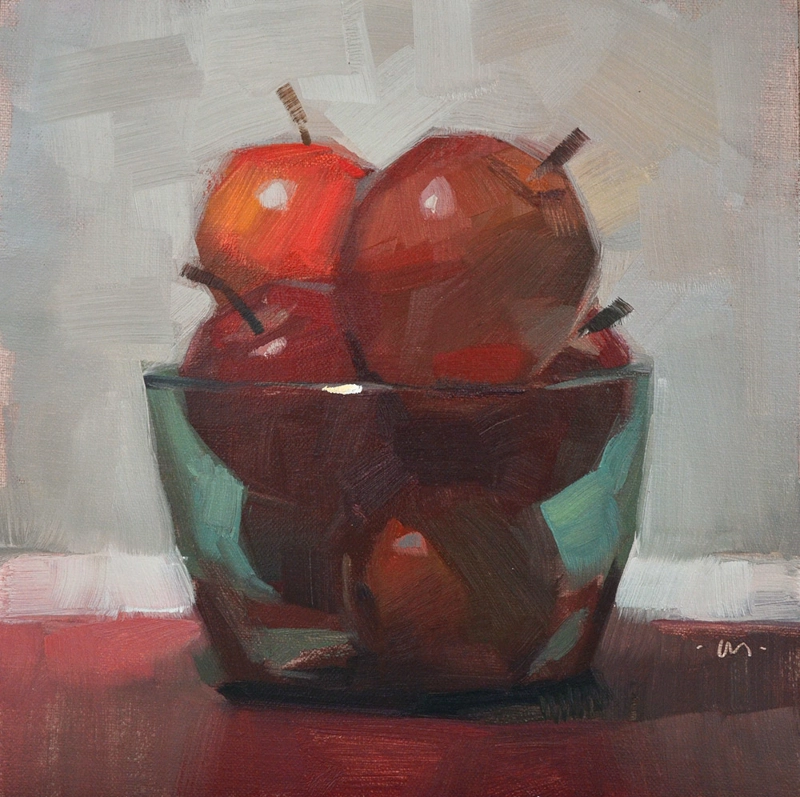
AZ: What surprising lessons have you learned along the way?
CM: Living as an artist is about balance. Sometimes, I need to push myself to get busy (I can procrastinate like crazy, especially if there is something new I am afraid of). Other times, when I am scraping the bottom of the creative barrel, I need to take a step back. In a creative endeavor, I can’t force myself to just do it.
AZ: 3 reasons why people should care about fine art.
CM: I really do not think people should care about fine art if they do not want to. People should do what they want to do. I have a friend who is always sayings that we need to educate the public about fine art. To some people art doesn’t speak. If it does, great. If they want to own it, even better. But, I don’t want to talk anyone into it.
AZ: Who do you admire most and why?
CM: My husband. He is an amazing guy, and my best friend. He has done amazing things with what he has been given.
Image courtesy of the following:
- Carol Marine
- Onasill ~ Bill Badzo Boise Idaho ~ Idaho State Capitol ~ Dome Skylight ~Historic via photopin (license)

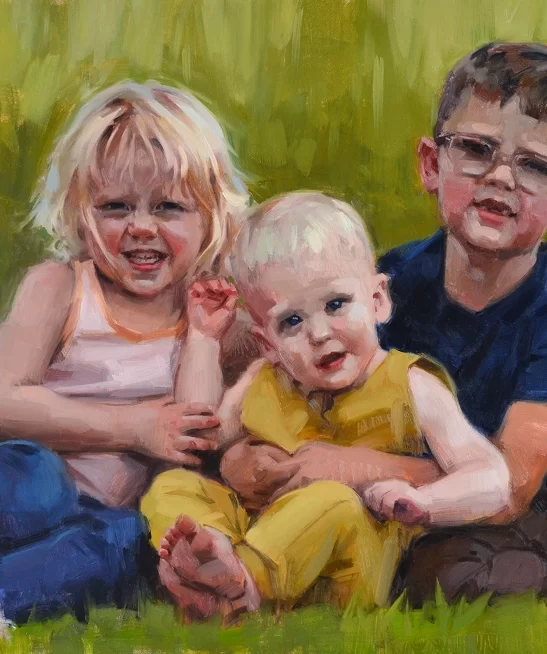
Leave a Reply